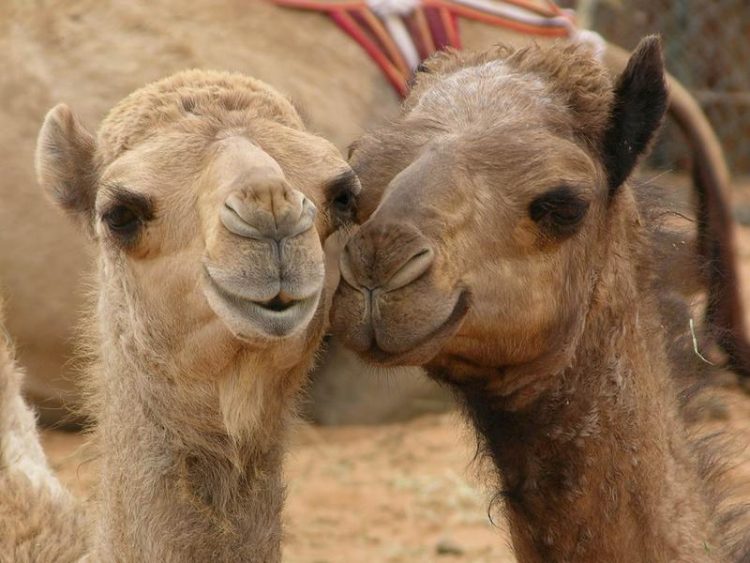MERS coronavirus can be transmitted from camel to man

MERS coronavirus is transmitted not only between animals but also from camels to humans. Photo: Norbert Nowotny / Vetmeduni Vienna
The so-called Middle East respiratory syndrome (MERS) coronavirus was first found in June 2012 in a patient from Saudi Arabia, who suffered from severe pneumonia. Since this time more than 300 persons have developed an infection, of whom about a third died. The fact that the Arabian camel is the origin of the infectious disease has been confirmed recently. The transmission pathways of the viruses, however, have not been clear until now.
Viruses in humans and camels from one region are identical
Virologists Norbert Nowotny and Jolanta Kolodziejek from the Institute of Virology are investigating the transmission pathways of the MERS coronavirus. They found that viruses from infected humans and Arabian camels from the same geographical region have nearly identical RNA sequences. “This indicates transmission between animals and man. The process is referred to as zoonosis. With this knowledge we can specifically react to the spread of the virus. Vaccinations of camels are currently being discussed. We will thus be able to halt the spread of the virus,” said Nowotny.
Virus RNA differs from region to region
The scientists investigated nasal and conjunctival swabs, taken from 76 camels in Oman. In five camels they found the MERS coronavirus and compared its RNA with those of MERS coronavirus from Qatar and Egypt. The analysis showed that the viruses differ from region to region. “This means that there is no specific 'camel MERS coronavirus strain', but that one virus infects both, camels and humans,” says study coordinator Norbert Nowotny.
Transmission pathway through nose and eyes
Virus levels were surprisingly high in the nasal mucosa and conjunctiva of camels. Therefore the scientists presume that the transmission pathway from animals to humans most likely occurs through these contact sites, especially through nasal discharge.
In man the virus causes severe pneumonia and renal failure while camels show no or very little symptoms (in some cases nasal discharge). So far all infections in humans have occurred in the Arabian Peninsula. However, some developed the disease after they returned to their native country, of whom eleven were from Europe. MERS coronavirus is also transmitted from one human to another, for instance in families, in the community, or through contact between patients and medical staff.
MERS and SARS coronaviruses are relatives
MERS coronavirus is closely related to SARS coronavirus. SARS originated in China and claimed 800 lives worldwide in 2002 and 2003. “While the SARS coronavirus probably crossed the species barrier only once by passing from bats to humans, we may presume that the MERS coronavirus is being constantly transmitted from camels to humans,” explains Nowotny.
The fact that MERS coronaviruses infect camels was shown by Nowotny and his colleagues in an earlier study, in which the scientists detected antibodies against the virus in the animals. The link to the study: http://www.sciencedirect.com/science/article/pii/S1473309913701646 The current genetic analysis of MERS coronarviruses permits more exact conclusions.
The paper “Middle East respiratory syndrome coronavirus (MERS-CoV) in dromedary camels, Oman, 2013” by Nowotny N. and Kolodziejek J. was published in the Journal Eurosurveillance. http://www.eurosurveillance.org/ViewArticle.aspx?ArticleId=20781
About the University of Veterinary Medicine, Vienna
The University of Veterinary Medicine, Vienna in Austria is one of the leading academic and research institutions in the field of Veterinary Sciences in Europe. About 1,200 employees and 2,300 students work on the campus in the north of Vienna which also houses five university clinics and various research sites. Outside of Vienna the university operates Teaching and Research Farms. http://www.vetmeduni.ac.at
Scientific Contact:
Prof. Norbert Nowotny
Institute of Virology
University of Veterinary Medicine Vienna (Vetmeduni Vienna)
norbert.nowotny@vetmeduni.ac.at
Released by:
Susanna Kautschitsch
Science Communication | Public Relations
University of Veterinary Medicine, Vienna (Vetmeduni Vienna)
Veterinärplatz 1, 1210 Wien
T +43 1 25077-1153
susanna.kautschitsch@vetmeduni.ac.at
http://www.vetmeduni.ac.at/en/infoservice/presseinformation/press-releases-2014/…
Media Contact
All latest news from the category: Life Sciences and Chemistry
Articles and reports from the Life Sciences and chemistry area deal with applied and basic research into modern biology, chemistry and human medicine.
Valuable information can be found on a range of life sciences fields including bacteriology, biochemistry, bionics, bioinformatics, biophysics, biotechnology, genetics, geobotany, human biology, marine biology, microbiology, molecular biology, cellular biology, zoology, bioinorganic chemistry, microchemistry and environmental chemistry.
Newest articles

Properties of new materials for microchips
… can now be measured well. Reseachers of Delft University of Technology demonstrated measuring performance properties of ultrathin silicon membranes. Making ever smaller and more powerful chips requires new ultrathin…

Floating solar’s potential
… to support sustainable development by addressing climate, water, and energy goals holistically. A new study published this week in Nature Energy raises the potential for floating solar photovoltaics (FPV)…

Skyrmions move at record speeds
… a step towards the computing of the future. An international research team led by scientists from the CNRS1 has discovered that the magnetic nanobubbles2 known as skyrmions can be…





















